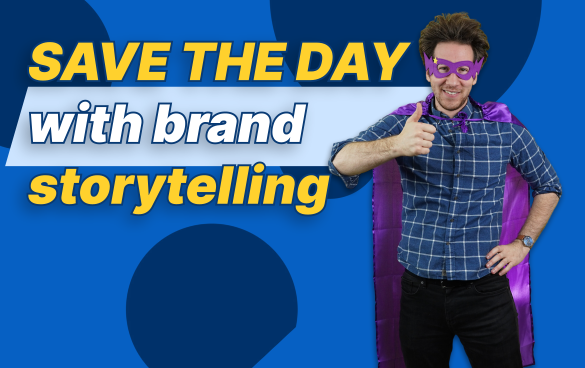-
 Published: Jan 17, 2022
Published: Jan 17, 2022
-
 8 min. read
8 min. read
-
 Jessica Bonacci
Jessica Bonacci Content Writer
Content Writer
- Jessica is a Google Analytics certified Digital Video Analyst at WebFX. She has created over 100 videos for the WebFX YouTube channel (youtube.com/webfx) in the last two years. Jessica specializes in video marketing and also loves content marketing, SEO, social media marketing, and many other aspects of digital marketing. When she’s not creating videos, Jessica enjoys listening to music, reading, writing, and watching movies.
Definition: Brand storytelling is the practice of using story to create a connection between your brand and its target audience. Brand storytelling examples include Dove’s Real Beauty campaign and Nike’s Just Do It campaign.
In this Revenue Weekly video, Dylan from the WebFX Earned Media team explains how brand storytelling can have a major impact on your marketing strategy.
Transcript:
I was just your average guy. Until one day, I stumbled upon a magical laptop. A sensation like lightning struck my fingertips. I started typing, and within minutes, I had become…super marketer. And now I’m on a quest to conquer the marketing world.
You can make your customers feel like superheroes when you use brand storytelling.
What is brand storytelling?
When you use storytelling in your marketing, you incorporate elements of a story into your content.
Remember that triangular diagram your English teacher would draw? I’ll recreate it for old time’s sake.
You start at the bottom with your exposition. An event occurs that leads to the rising action. At the peak, you have the climax where everything comes to a head, and then things start to wrap up with the falling action and the resolution.
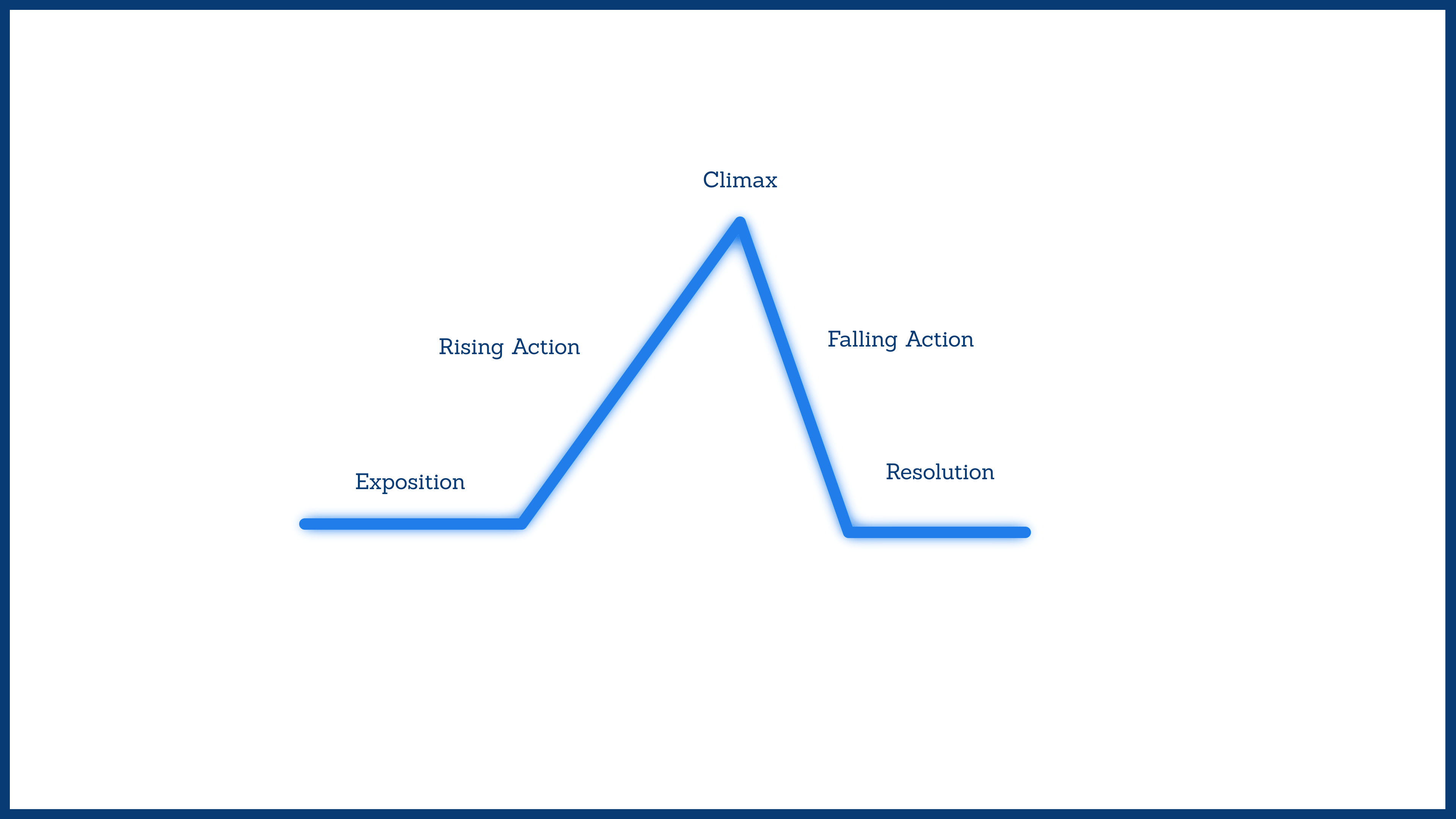
You might not think literature and marketing match up, but I assure you they do. And they work together harmoniously.
Storytelling marketing is not just explaining how your company came to be or making up a fake superhero legend for attention (although that is quite fun).
It’s an audience-centric tactic focused on capturing attention through narrative and emotion. You look for ways to relate to your audience, so they learn to trust your business and, eventually, come to you when they need something you offer.
When you present a product or service using a story, you don’t say, “Here is my product or service. It is the best thing to ever exist, and you need it.”
Instead, you tell the story of a person who’s frustrated and struggling to overcome a challenge. They don’t know what to do, so they nearly give up. But as they’re about to throw in the towel, they find your business. They call you, you help them, they achieve their goals, and their life is changed for good.
This approach is not all about you and how great you are. It’s about how the customer can live their best life and achieve their goals because they made a good decision and chose you.
Why is brand storytelling important?
Storytelling is memorable
A study from Stanford University, cited by the PRSA, tells us that people remember stories more than they remember straight facts.
When people listened to short speeches that featured three statistics and one story, just five percent of the audience remembered statistics, while more than 60 percent could recall stories. So even though the facts outnumbered the stories, the stories still caught people’s attention.
It’s so easy for your content to get lost among the clutter, so anything you can do to be remembered is critical to your success.
Storytelling taps into emotions
According to USC, an emotional response to an ad can greatly impact a customer’s decision making. The statistics from USC back this up by showing that 31% of ad campaigns with emotional content performed well, compared to just 16% of ads with rational content.
The best-performing emotional themes, according to USC, include: Pride, love, achievement, empathy, friendships, loneliness, and memories.
Storytelling makes your brand relatable
If people identify with the stories you tell and your identity, they’ll feel more comfortable listening to you, trusting you, and, in the case of a business, purchasing from you. This shared identity concept from Dr. Robert Cialdini — author of “Influence” — comes from something referred to as the Unity Principle.
So basically, if you want to improve your marketing campaigns, add elements of storytelling. I’ll give some examples of how you can do that next.
How to use brand storytelling to connect with your audience
1. Share your customers’ stories
An excellent way to connect with potential customers is to showcase your current (happy) customers. Let customer stories shine to show your audience how they, too, can achieve their goals or solve their problems.
A classic approach to introducing your customers is using testimonials. When creating your testimonials — whether they’re in text, graphic, or video format — ask your customers some of the following questions:
- What was life like before coming to our company?
- Why did you decide to make a change?
- What did you want to achieve with our team?
- How did you achieve your goals with us?
- What is life like now?
We’ve used this format for our own testimonials, which you can view in our portfolio.
You don’t have to stick to a rigid question and answer outline, though.
Let’s use Apple for some brand storytelling examples. Their “Behind the Mac” videos show how Macs play an important role in people’s lives — without being too self-promotional. The videos focus on the Mac users and their successes, not how great the Macs are.
In one video, musical artist FINNEAS tells the story of how he produces music. And he just so happens to use his Mac.
Apple also shared a video of students getting accepted to college. What computer are they using when they get the acceptance letter? A Mac.
I’ve linked to these videos in the description if you want to check them out later.
They’re emotional. They’re sentimental. They’re relatable. Everything you want in a brand story.
That brings me to my next point.
2. Get emotional
Don’t be afraid to make your audience feel all the feelings.
You can show how your animal shelter saves stray cats and dogs using a van they got from your business, or how a father taught his daughter to play baseball with one of your bats. It’s just so sweet.
Speaking of sweet, in a simple Instagram post, Hershey captured what it means to share a Kiss.
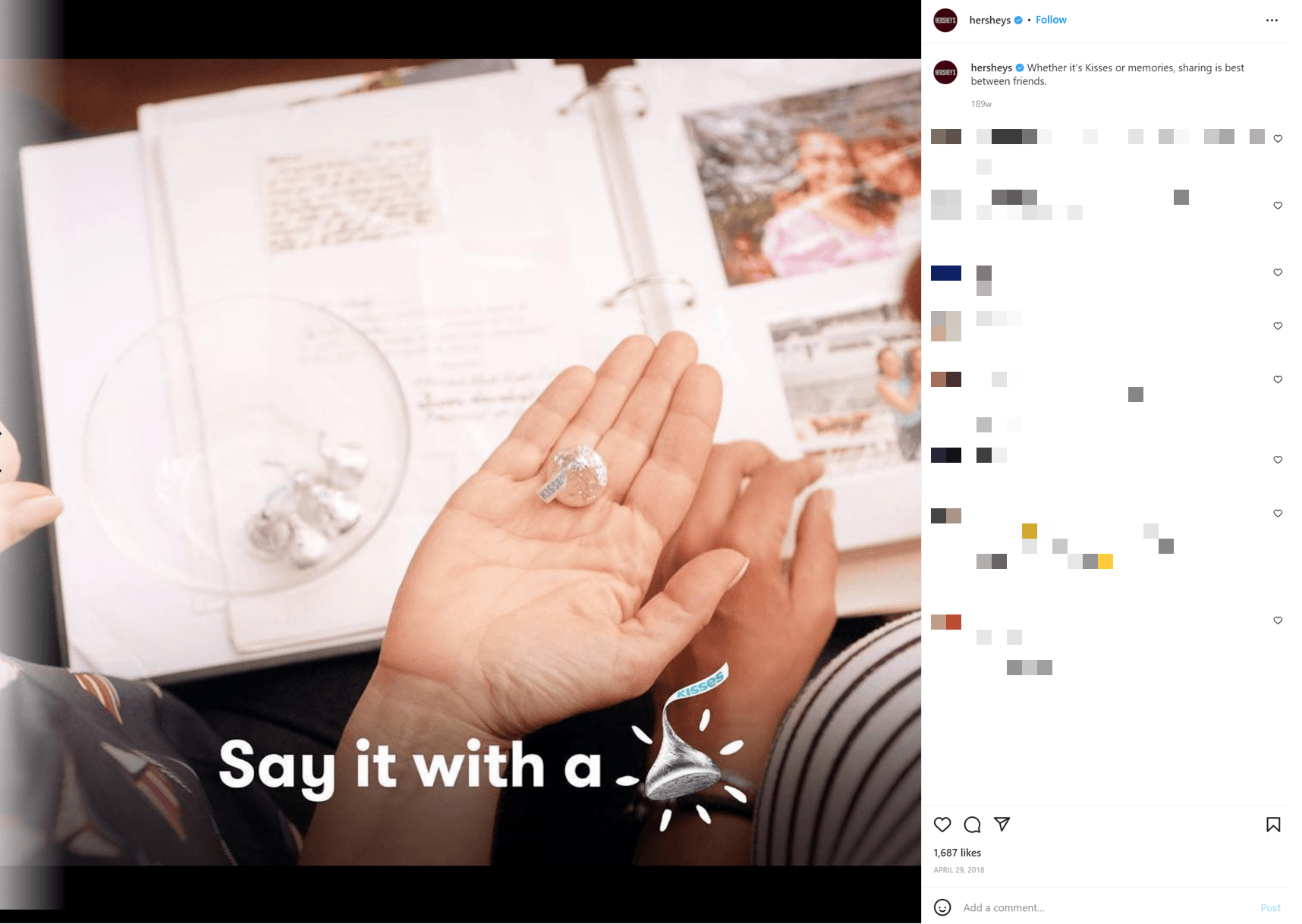
In the photo, you see a hand holding a Hershey’s Kiss, but if you look closer, you notice that the two people in the photo are looking at a scrapbook. They’re sharing memories while sharing a Hershey’s Kiss. This post evokes the themes of love and friendship I mentioned earlier, making it so effective at grabbing attention.
While making people tear up is always an option, you can make people smile, too. Maybe even make them laugh.
According to the University of Pennsylvania, one study showed that people who receive news about politics and government in a humorous way are more likely to share it.
While you might not be delivering the daily news, you can still incorporate humor into your brand storytelling and maximize the amount of times people share your content with others.
Let’s look at Old Spice as an example. They use humor quite frequently to promote their brand, all while highlighting how their products can help their audience.
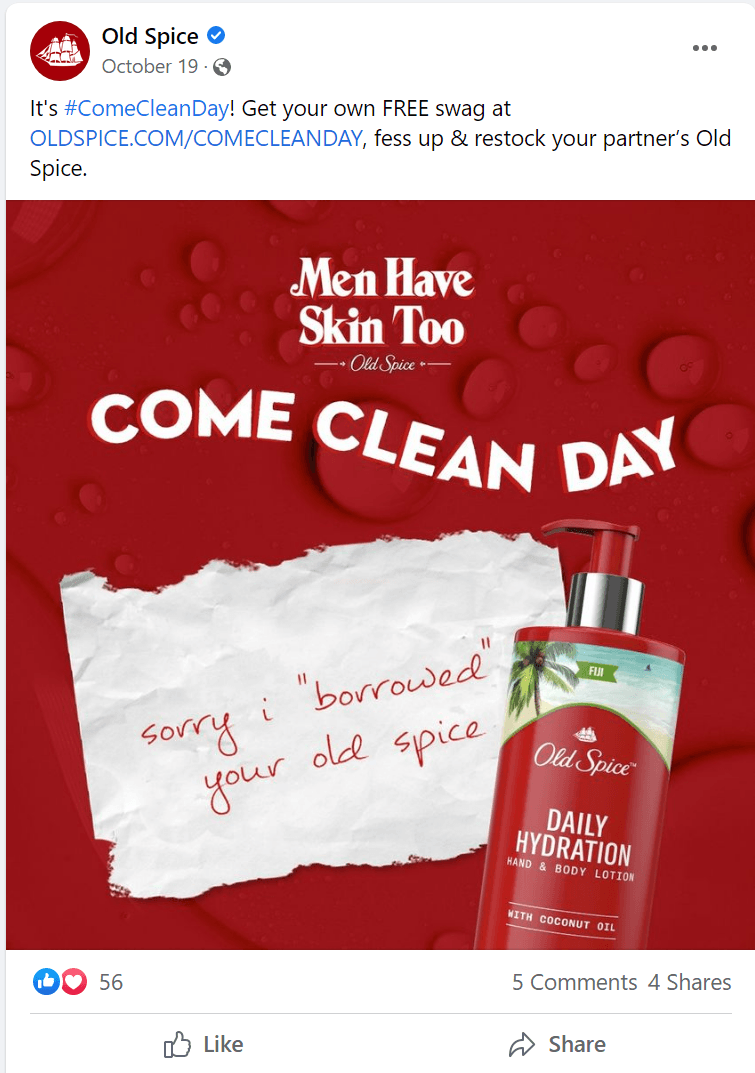
The emotion you choose to evoke with your stories depends a lot on your company. If you’re a serious law firm, you may not want to follow in Old Spice’s footsteps and produce comical stories. If you’re a daycare, you can likely go the comedic route.
Knowing your business and what you’re all about is key to the emotional aspect of your storytelling marketing.
3. Address an obstacle your audience faces
What challenges will your audience overcome when they choose your business?
People often seek out new products and services to solve problems, so you should consider highlighting those problems and explaining your solutions.
By speaking directly to your audience and addressing their pain points, you make your business more relatable. As we know, relatability is a great way to earn people’s trust.
I’ll use the communication tool Slack as an example of a company that addresses obstacles.
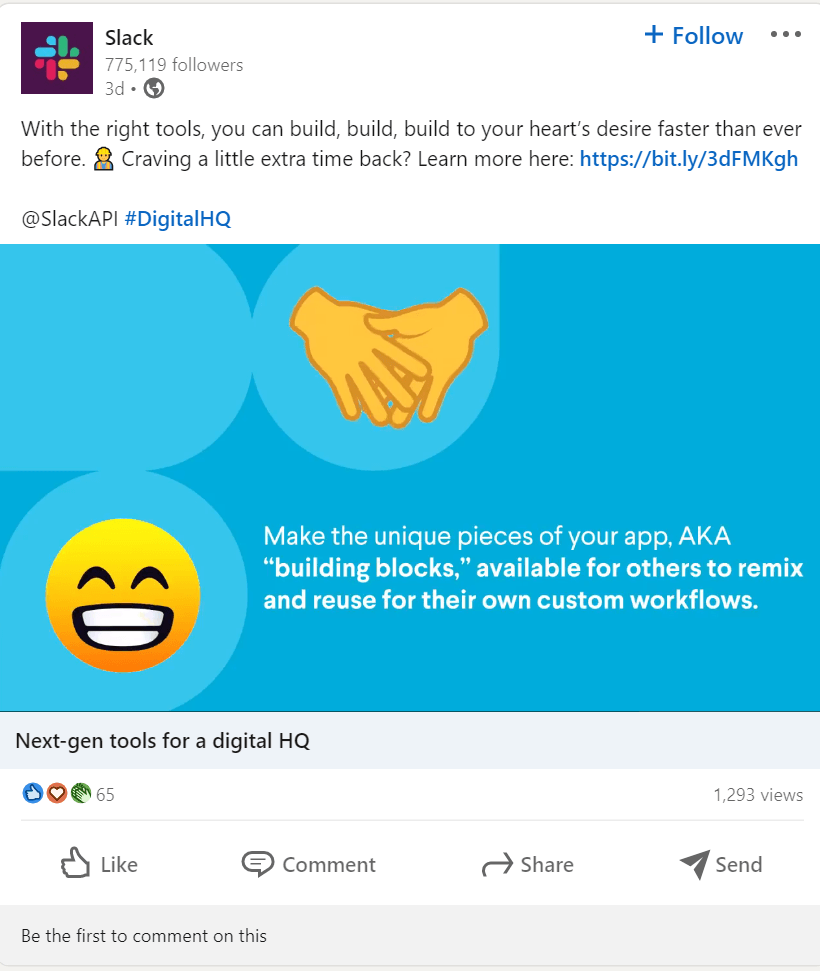
In a LinkedIn post, Slack identified the common workplace issue of having too much to do and not enough time to do it. In just a few sentences, they highlighted a common experience and shared how they can help.
The post content isn’t just about Slack’s features. It’s focused on what the potential user can do with Slack.
And a really big takeaway from these brand storytelling examples is that you don’t have to spend all of your marketing budget on a complex project. With a simple graphic and the right copy, you can tell a story that makes people want to invest in your business.
And they all lived happily ever after. Once they subscribed to our YouTube channel and Revenue Weekly, our email newsletter.
Thanks for tuning in to this video about brand storytelling. If you have any questions, drop them in the [YouTube] comments. We’d love to hear from you!
See you next time!
We post videos every Monday.
Yup. Every Monday.
Join the 12,000 marketers who get their marketing knowledge from WebFX videos.
Subscribe Now

-
 Jessica is a Google Analytics certified Digital Video Analyst at WebFX. She has created over 100 videos for the WebFX YouTube channel (youtube.com/webfx) in the last two years. Jessica specializes in video marketing and also loves content marketing, SEO, social media marketing, and many other aspects of digital marketing. When she’s not creating videos, Jessica enjoys listening to music, reading, writing, and watching movies.
Jessica is a Google Analytics certified Digital Video Analyst at WebFX. She has created over 100 videos for the WebFX YouTube channel (youtube.com/webfx) in the last two years. Jessica specializes in video marketing and also loves content marketing, SEO, social media marketing, and many other aspects of digital marketing. When she’s not creating videos, Jessica enjoys listening to music, reading, writing, and watching movies. -

WebFX is a full-service marketing agency with 1,100+ client reviews and a 4.9-star rating on Clutch! Find out how our expert team and revenue-accelerating tech can drive results for you! Learn more
Try our free Marketing Calculator
Craft a tailored online marketing strategy! Utilize our free Internet marketing calculator for a custom plan based on your location, reach, timeframe, and budget.
Plan Your Marketing Budget

Maximize Your Marketing ROI
Claim your free eBook packed with proven strategies to boost your marketing efforts.
Get the GuideTry our free Marketing Calculator
Craft a tailored online marketing strategy! Utilize our free Internet marketing calculator for a custom plan based on your location, reach, timeframe, and budget.
Plan Your Marketing Budget

